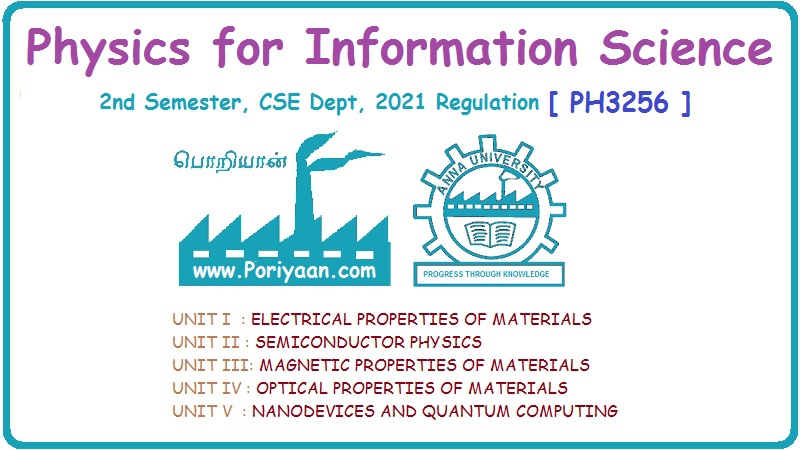Physics for Information Science: Unit I: Electrical Properties of Materials
Energy Distribution of Electrons in Metals
We know according to Quantum free electron theory the energy levels are discrete (microscopically). But since the spacing between any two energy levels is very less (10-6 eV), the distribution of energy levels seems to be continuous. (macroscopically).
ENERGY DISTRIBUTION
OF ELECTRONS IN METALS
We
know according to Quantum free electron theory the energy levels are discrete
(microscopically). But since the spacing between any two energy levels is very
less (10-6 eV), the distribution of energy levels seems to be
continuous. (macroscopically).
Proof:
We
know the energy eigen value in three dimension is
This equation represents the permissible energy values of the valence electrons in a cubical metal piece. If the cubical metal piece has a dimension say 1cm3, then the ground state energy is given by
Also,
the maximum spacing between the consecutive energy level is very less, say in
the order of 10-6 eV.
If
a plot is made between the number of energy levels N (E) that are filled with
electrons per unit energy and Energy E, it is found that the number of energy
levels N(E) increases parabolically with the increase of energy 'E' as shown in
Fig. 1.8.
In
figure 1.8, the dotted line shows the change in energy of electron at room
temperature.
Here
each energy level can provide only two states, one for spin up and the other
for spin down. Hence only 2 electrons can be filled in a given energy state as
shown in Fig. 1.9. Thus the Pauli's exclusion principle is satisfied.
At
T=0, if there are 'N' number of electrons (N being even), then we have N/2
number of filled energy levels and other higher energy levels will be
completely empty.
This
(N/2)th level is the highest filled energy level, called Fermi
Energy level
Fermi Energy and its importance
Fermi
energy level (EF): Fermi energy level is the maximum energy level
upto which the electrons can be filled at OK.
Importance
(i)
Thus it act as a reference level which seperates the vacant and filled states
at OK.
(ii)
It gives the information about the filled electrons states and the empty
states.
(iii)
At OK, below Fermi energy level electrons are filled at above Fermi energy
level it will be empty.
(iv)
When the temperature is increased, few electron gains the thermal energy and it
goes to higher energy levels.
Conclusions
(i)
In the quantum free electron theory, though the energy levels are decrete
(microscopically), the spacing between consecutive energy level is very less
and thus the distribution of energy levels seems to be continuous.
(ii)
The number of energy levels N(E) that are filled with electrons per unit energy
increases parabolically with the increase of energy E as shown in Fig. 1.8
(iii)Each
energy level can provide only two states, namely, one for spin up and the other
for spin down and hence only 2 electrons can be occupied in a given energy
state i.e., paulis exclusion principle.
(iv)
At T=0, If there are 'N' number of electrons (N being even), then we have N/2
number of filled energy levels and the other higher energy levels will be
completely empty.
(v)
This (N/2)th level is the highest filled energy level is known as Fermi energy level (EF0).
(vi)
The electrons are filled in a given energy level, according to pauli's
exclusion principle (i.e) No two electrons will have the same set of four
quantum numbers, as shown in Fig. 1.9.
(vii)
At Room temperature, the electrons within the range of KB T [where KB
→ Boltzmann constant] below the Fermi energy level will absorb ̴ Kg T and goes
to higher energy states with energy + EFo + KBT as shown
in Fig. 1.8.
Physics for Information Science: Unit I: Electrical Properties of Materials : Tag: : - Energy Distribution of Electrons in Metals
Related Topics
Related Subjects
Physics for Information Science
PH3256 2nd Semester CSE Dept | 2021 Regulation | 2nd Semester CSE Dept 2021 Regulation
